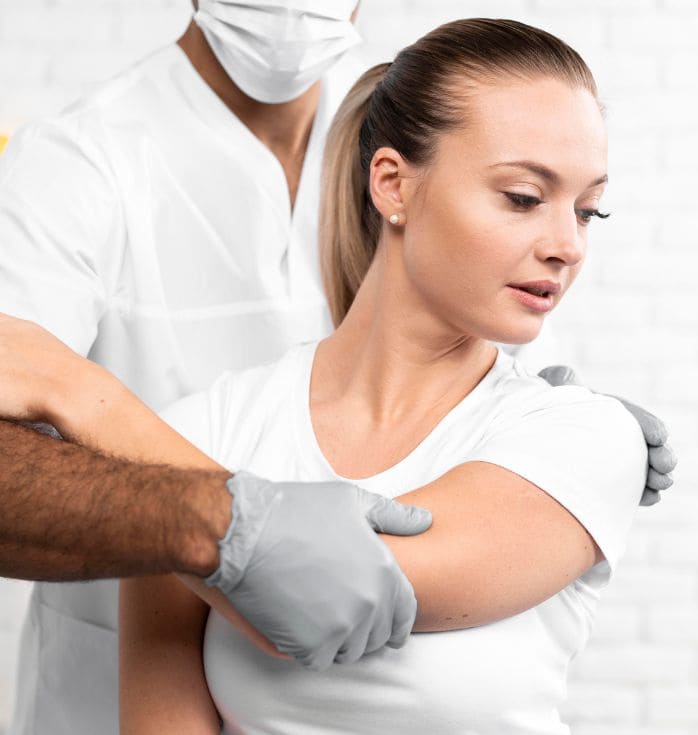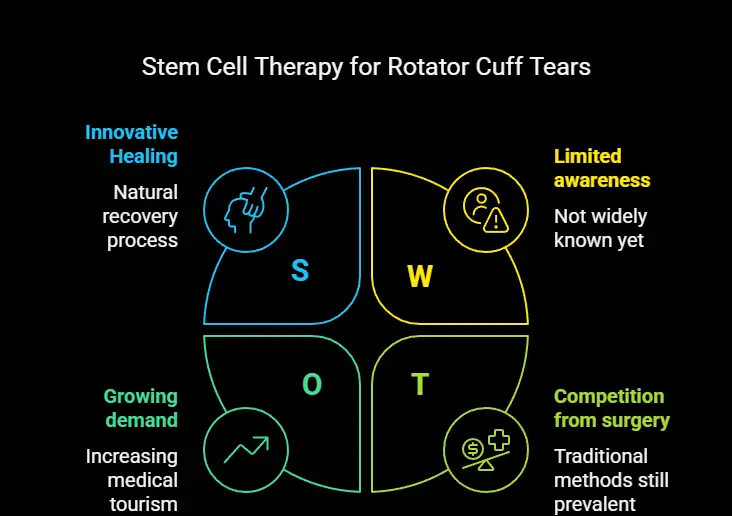Stem cell therapy for rotator cuff tear stands out as a breakthrough solution in regenerative medicine. Traditional surgery doesn’t deal very well with these injuries and fails 20% to 90% of the time. The numbers become even more relevant since about 30% of people over 60 years old have rotator cuff tendon tears, often leading to chronic shoulder pain.
Stem cell treatment works differently than regular surgery and helps your body heal naturally. Mesenchymal stem cells from Wharton’s jelly show amazing healing abilities. These cells can change into muscle, tendon, cartilage, and blood cells. On top of that, patients who choose stem cell therapy for torn rotator cuff live better lives, and many don’t need surgery at all.
Medical tourism sees 14 million people traveling worldwide each year. Over the last several years, Regencord in Pereira, Colombia, has become a top destination for stem cell rotator cuff repair. This center provides advanced treatments that target the injury's root cause instead of just hiding the symptoms.


Rotator cuff tears are a common shoulder problem that affects millions worldwide. These injuries become more prevalent as people age and can make simple daily tasks painful and difficult, often requiring stem cell treatment for shoulder injuries.
Your rotator cuff muscles, including the supraspinatus tendon, infraspinatus tendon, subscapularis muscle, and teres minor muscle, keep your shoulder stable and help you move your arm. Natural wear and tear starts around age 30, and the risk of tears goes up after 50. Research shows people over 60 face the highest risk. While aging naturally causes these tears, several factors speed up this process:
These injuries need proper treatment. If left untreated, your shoulder might never regain its full strength or range of motion, which is why many are turning to stem cells for shoulder injuries.
Traditional rotator cuff repairs face tough challenges despite better surgical techniques. The surgery can't regenerate the delicate fibrocartilaginous zone between the tendon and bone. The repair creates scar tissue that's mechanically weak, often failing to restore proper shoulder joint stability.
Tear size affects surgical success rates. Small tears fail 5% of the time, moderate tears 20%, large tears 27%, and massive tears fail 50-90% of the time. Patients under 70 with massive irreparable tears might need superior capsular reconstruction, partial repair, or reverse total shoulder arthroplasty.
Recovery takes 4-6 months, and patients say their shoulders don't feel normal until about nine months after surgery. This long recovery period disrupts daily life, making stem cell therapy for shoulder injury an attractive alternative.
Stem cell therapy brings a fundamental change to rotator cuff treatment. This approach enhances biological healing instead of just mechanically fixing torn tissues. Mesenchymal stem cells (MSCs) are valuable because they:
Doctors can get MSCs from bone marrow, fat tissue, and Wharton's jelly. Fat-derived stem cells (ADSCs) show great promise in clinical studies. Research shows patients who received ADSCs during arthroscopic repair had fewer retears (14.3% compared to 28.5%).
Stem cell therapy might speed up healing with less invasive procedures than traditional surgery. This matters a lot to active people who want to avoid long recovery periods and are seeking effective stem cell treatment for rotator cuff tear.

Stem cells’ power to regenerate has changed how we treat tendon injuries. These cells provide a biological solution that goes beyond mechanical repair. So understanding the science behind this therapy helps explain why it shows such promise for rotator cuff healing and improving biomechanical strength.
Mesenchymal stem cells (MSCs) are multipotent stromal cells that can renew themselves and turn into various mesodermal tissues. These remarkable cells transform into tenocytes, bone cells, cartilage cells, and adipocytes. MSCs show high proliferative and synthetic activities compared to fully differentiated cells, which makes them perfect for tissue regeneration. Scientists can harvest them from several sources:
MSCs do more than just differentiate. They have powerful immunomodulatory and anti-inflammatory properties that help calm the inflammatory responses we often see with tendon injuries.
MSCs make rotator cuff healing easier in several ways. These cells reduce acute inflammation where the injury occurs. They then boost the biological environment for repair by releasing growth factors and cytokines that arrange the healing process.
MSCs actively help regenerate tissue by promoting collagen formation and improving how fibers arrange themselves in the extracellular matrix. Research showed UC-MSCs could stop rotator cuff tears from getting worse by preventing tear size increase. These cells also improve tendon thickness, reduce inflammation, and strengthen connections to surrounding tissue, enhancing the tendon-bone interface.
Wharton's jelly, the gelatinous substance in umbilical cords, has become the best source of MSCs. The jelly has more MSCs than other tissue types. Its collagen fibers match the extracellular matrices found in human articular cartilage, tendons, and dermal tissues.
In addition, Wharton's jelly contains collagen fiber types I, III, and V, cytokines, proteoglycans, growth factors, and hyaluronic acid. These components are great for musculoskeletal repair. Doctors can obtain these cells without invasive procedures since hospitals usually discard umbilical cords after delivery.
Clinical studies have shown excellent results. The research found that using Wharton's jelly led to significant improvements in function, joint mobility, and pain relief, making it a preferred choice for stem cell therapy rotator cuff treatments.


Regencord Pereira offers stem cell therapy for rotator cuff tear through a well-laid-out treatment plan that maximizes results. The clinic has treated more than 5,000 patients with various conditions in the last 11 years. Their records show that 95% of patients reported positive results without serious adverse effects.
The medical team at Regencord starts with a detailed evaluation. They review your complete medical history and conduct a physical examination. Imaging studies help assess how severe the rotator cuff tear is and may include checking bone mineral density. This gives them a full picture to determine if stem cell therapy would work for you. The team provides expert medical advice with empathy and professionalism.
Once eligibility is confirmed, the stem cell procedure begins. The team may harvest stem cells from your own body (autologous stem cells) or use cells from an external source (allogeneic). Most autologous treatments collect cells from bone marrow in the pelvis area. Regencord's laboratory processes and purifies these cells to select the healthiest, most effective ones.
Doctors perform stem cell injections for the shoulder precisely into the damaged rotator cuff tendon. They use ultrasound or fluoroscopy guidance to ensure accuracy. This precision helps stem cells reach exactly where healing needs to happen. You'll spend just a few hours for the whole procedure.
Most patients can return to light activities within 1-2 days after treatment. The healing continues well after you leave the clinic. Patients notice their first signs of pain relief as stem cells integrate with the surrounding tissue during weeks 2-6. You should avoid anti-inflammatory medications during this time since they can affect how stem cells work.
Pain levels and shoulder function show noticeable improvements between 1-3 months. Physical therapy should start 4-6 days after the procedure for best results. Activities can gradually resume as your shoulder heals. Stem cell therapy continues to work for 6-12 months until complete structural healing and regeneration occurs, often surpassing the results seen with traditional tendon repair techniques.
Stem cell therapy has proven better than traditional rotator cuff surgery. This innovative treatment helps patients heal faster and recover sooner. The results speak for themselves—Regencord Pereira’s work with over 5,000 patients shows an amazing 95% success rate. The largest longitudinal study reveals impressive numbers: 87% of patients who chose stem cell therapy kept their rotator cuffs intact after ten years, whereas traditional treatments only managed 44%.
MRI studies and clinical research confirm these findings. Stem cell therapy doesn’t just mask pain—it regenerates tissue and restores full shoulder movement. This advanced treatment gives patients a real shot at lasting recovery, making it a cornerstone of modern regenerative medicine approaches to shoulder injuries. Contact Regencord Pereira today and take the first step toward healing. Schedule your consultation now and get back to living life without limitations!
3-Step Process for Stem Cell Treatment for Arthritis in Hands
Stem cells are unique cells with the ability to develop into various cell types and repair damaged tissues. They are used in regenerative medicine, including treatments for cancer, neurodegenerative diseases, and injuries. Sources include bone marrow, cord blood, and embryos.
(888) 540-4101
Begin your journey with us today! Call us at (888) 540-4101 or complete the form to learn more.


